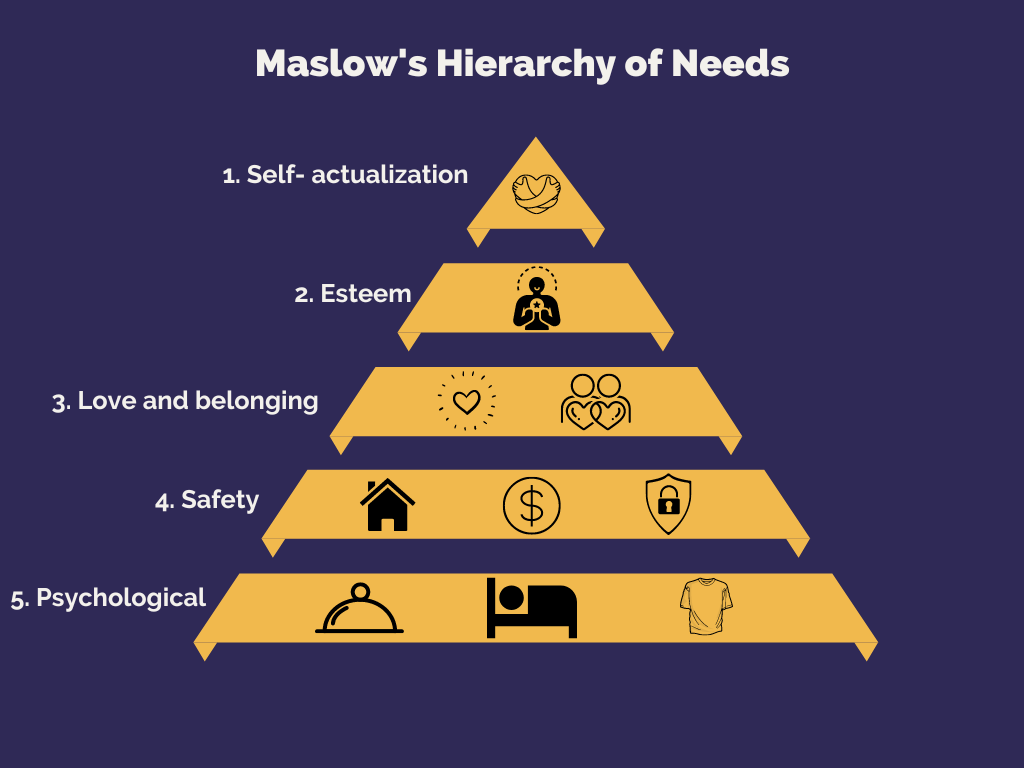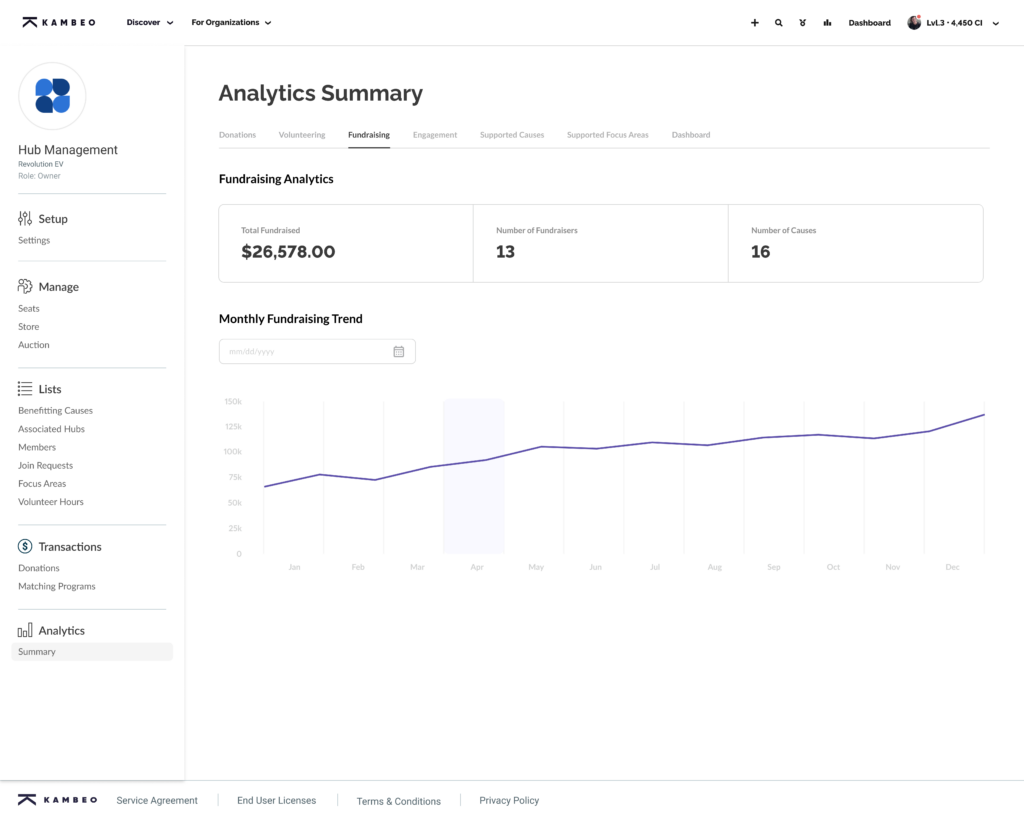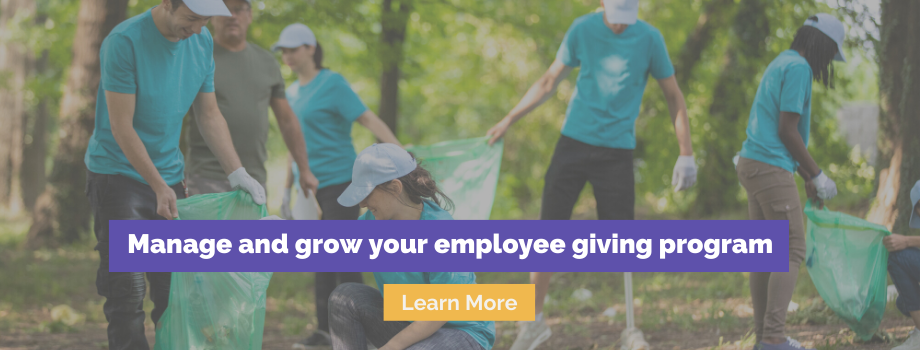The most valuable asset of any organization is its employees. Creativity, critical reasoning, problem-solving, and strategy would lack without these individuals.
Therefore, retaining top talent to avoid high turnover rates (which also comes with the expensive cost of replacing new employees) is essential. While there are many tactics to retain top talent, meeting your employees’ basic needs remains one of the most important contributors.
Under Maslow’s Hierarchy of Needs, self-actualization—in which an individual wants to reach their full potential— lies at the top of an employee’s basic needs. As employees look for new avenues to help them reach their full potential at work, leaders can facilitate an employee’s desire for personal growth & development by starting an employee giving program.

An employee giving program provides employees with new skills, experiences, and expertise, which in turn helps them to feel fulfilled at work—meeting their need for self-actualization.
Whether you have been contemplating the idea of starting an employee giving program in the past or have just become familiar with the term, this blog will walk you through how to start an employee giving program in 7 steps:
What Is An Employee Giving Program?
A program where an organization empowers and equips its employees with the necessary resources for them to become active community contributors. Organizations will typically lay the groundwork, helping to find causes and charitable activities that their employees can contribute to, then watching as their charitable efforts turn into results.
Some charitable giving activities include:
- Volunteering
- In-person/virtual events
- Fundraisers
- Donations
- Nonprofit merchandise sales
With more than 1.54 million charitable organizations in the United States in need of support, now is the time to get your organization equipped and your employees onboarded to have a big social impact (that may have only been an abstract thought before!).
Getting Started with an Employee Giving Program:
1. Define what initiatives you want to pursue
There are many ways to merge the world of philanthropy with the corporate world. Looking at the list of charitable giving activities above, this may seem like a lot to tackle at first.
Start by making a list of what activities you want to pursue as a company in the first year.
A hypothetical list could look something like this:
- One company-wide volunteer day
- One third-party fundraiser
- Four donations
- One crowdfunding campaign
Be realistic with your list (and note that this can always change). You may have the capacity to take on more as the year progresses, or you may find that you need to cut back on a donation or push a fundraiser by a few months.
Having a general idea of what you would like to accomplish as a team (as an organization) will help set you up for the next steps.
2. Secure corporate-nonprofit partnerships
While the keyword of an employee giving program is employees, one of the first steps to starting one is to connect with local causes in your community. These corporate-nonprofit relationships are the pillar to making your program successful. Once causes are selected, initiatives can be found (or created), social impact can be generated and amplified, and the results of your efforts can be measured and tracked.
When searching for a non-profit partner, find one whose mission, vision, and objectives align with your organizational values. For example, if you sell medical supplies, maybe you could support the philanthropic arm of a hospital. After all, you’re both committed to quality healthcare and improving patient outcomes.
A corporate nonprofit partnership is more than just an entry point to find socially responsible initiatives your employees can partake in. Your organization is raising awareness around an important issue (i.e., improving the quality of healthcare) and giving nonprofits opportunities they may not have had otherwise without your financial support.
3. Educate employees
While some employees may be volunteering on weekends or making annual donations to causes outside an employee giving program, other employees want to start giving back as part of a workplace program but may not know the benefits.
To help these individuals understand how employee giving programs can make a big difference in their communities, here are a few benefits to mention:
- Give back in ways that are meaningful to you. Whether that is through attending an event or making a donation, the act of giving can be personalized to individual preferences.
- Connect with a variety of nonprofits and charities (vetted by your workplace) who are in need of your support.
- Improve work-life balance, such as improving physical well-being and reducing stress.
- Gain a sense of purpose, boost self-confidence, and cultivate new community connections.
4. Build company-wide initiatives
Engage with your current nonprofit partner(s) to inquire about how you can maximize your charitable efforts to have a positive community impact. If these causes have a volunteer day or fundraiser they are currently running, your employees can effortlessly participate; however, some initiatives can be entirely organized and managed by your company.
Is there a third-party fundraiser volunteer day that you can fully plan and execute? If the answer is yes, immediately sort out the logistics of the event:
- Where will it take place?
- What is the date/time?
- How many employees are expected to make this initiative a success?
- How will employee attendance be tracked?
- What are the expectations from the nonprofit you are hosting the event on behalf of?
After the logistics have been sorted, now is the time to spread awareness, which starts by inviting your employees. Employees want to feel proud of the company they work for and participate as a team for a greater cause—company-wide initiatives accomplish that objective.
Organize the event during work hours, send frequent email reminders, and educate your employees on the strategic partnership you have developed: who is the nonprofit, what is their mission, and why is this partnership a good fit for both parties?
Communicating the above will incline employees to see the value of attending a company-wide fundraiser and becoming engaged participants.

5. Offer autonomy
You know it is healthy to give your employees autonomy to learn, grow, and develop in the workplace.
Now, apply that fundamental value to an employee giving program. There may be causes your employees want to support that aren’t currently included in your list of nonprofits & charities, or there may be a volunteer opportunity they want to participate in individually.
- Give one volunteer day per quarter, so employees can get out and give back on company time.
- Provide links to online resources where employees can discover and connect with causes your organization doesn’t currently support.
- Equip employees with the resources they need to organize and execute a peer-to-peer fundraiser or company-wide volunteer day: both efforts that promote unity among team members.
6. Develop a value around employee giving
Values are the reason why an organization exists; they guide the decisions and actions of all employees. A values-based culture, with detailed values like the below, has the power to motivate and guide employees’ actions:
- Value 1- Gain creativity from cultural diversity.
- Value 2- Uphold a commitment to our customers, investors, and employees.
- Value 3- Lead with tenacity and enthusiasm.
Notice what is missing from the above? A value tied to employee giving. If we were to add something along the lines of: “Give back with empathy, care, and respect,” employees will realize that corporate giving is a vital part of their organizational culture and, as a result, will be more inclined to take part in their organization’s employee giving program.
7. Measure success
After all the time, effort, and resources that have gone into connecting with causes, building company-wide initiatives, and maximizing employee participation—it doesn’t end there.
How will you measure the results from an employee giving program? Without proper metrics in place, it will be nearly impossible to assess the impact of your program and measure employee engagement.
This is where a social impact platform comes in, with its unique ability to track progress across your entire employee giving program. Questions can be answered, such as:
- How many employees are taking part in volunteer opportunities?
- How many volunteer hours have our employees accumulated?
- How much are employees donating?
- How many donations have been made by employees?
- How much have our employees raised through fundraisers?


Employees are more than just a body to occupy a 9-5 role. Within an organization, they can also be active supporters who help make a difference in their communities. However, it’s the role of a visionary leader to provide them with the resources—such as an employee giving program—to support them in taking that jump to become impactful changemakers.



